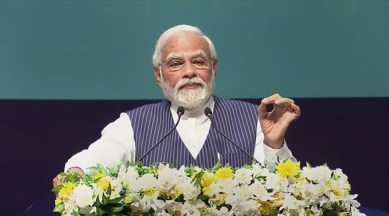Stay updated with the latest - Click here to follow us on Instagram
PM Modi hails Digital India, says it helped save Rs 2.25 lakh crore from falling in wrong hands
PM Narendra Modi said the trio of Jan Dhan, Mobile and Aadhaar, or JAM, have “provided maximum benefit to the poor and the middle class”.

The Digital India campaign has helped save Rs 2.25 lakh crore from falling into the wrong hands in the past eight years, said Prime Minister Narendra Modi in Gandhinagar Monday. The campaign has also helped to eliminate middle-men, he said while inaugurating “Digital India Week 2022” and a Digital Expo at Mahatma Mandir in the city.
“The transparency that has come due to Digital India has eliminated corruption at various levels adversely affecting the poor and the middle class. We have seen that period when it was difficult to get a service without paying a bribe. Digital India has saved money for the common man… ending the network of middle-men,” said PM Modi while speaking on the seventh anniversary of launching the “Digital India” campaign, a flagship programme of the Central government.
“In the last eight years, more than Rs 23 lakh crore has been transferred through Direct Benefit Transfer (DBT) to beneficiaries. Due to this technology, almost Rs 2.25 lakh crore that would have landed in the wrong hands have been saved,” he added. He said the trio of Jan Dhan, Mobile and Aadhaar, or JAM, have “provided maximum benefit to the poor and the middle class”. The Digital India campaign has also helped eliminate “queues” in the country.
“It will touch your hearts to know how Digital India helped missing children reconnect with their parents,” he said as he narrated the story of a young girl from Uttar Pradesh who got lost on a railway platform when was six years old. “She was not able to tell her address or anything about her parents whereabouts. She had an Aadhaar card already registered in her name. Using this data, her parents were found,” said Modi, adding that the girl was reunited with her parents at age of 14 using the Aadhaar data. “Similarly, more than 500 children from different places have been reunited with their parents using this technology.”
Gujarat Chief Minister Bhupendra Patel, Union Minister for Electronics and Information Technology Ashwini Vaishnaw and Union Minister of State Rajeev Chandrasekhar were also present at the event where PM Modi launched a host of digital platforms and services, including Indiastack.global, myscheme, Meri Pehchan, Digital India Bhashini, Digital India Genesis, Chips to Start-ups and an e-book.
The Prime Minister said it was Digital India that helped the government tackle the crisis arising out of Covid pandemic. “CoWin and Aarogya Setu are two mobile applications that helped provide 200 crore vaccine doses. The world is still debating how to generate vaccine certificates and in India, the certificate is available immediately after a vaccine dose is taken,” he said, adding that his critics are stuck at why the vaccine certificates carry
Modi’s photograph.
PM Modi also mentioned how GIFT City was emerging as a fintech hub. He said India’s Unified Payment Interface (UPI) has been appreciated by the World Bank and others. “Just in May this year, India conducted 1.3 lakh UPI transactions every minute. In other words, 2200 transactions were conducted every second. Be it developed countries or those who cannot invest in such technology, India’s digital product—UPI—is the centre of attraction. We have scale in our digital solutions. They are secure and have democratic values,” he added.
Digital India has also helped bridge the digital divide that exists between rural and urban India, the Prime Minister said. Talking about his recent visit to Dahod (a tribal area in Gujarat), PM Modi said he met a divyang couple who were operating a common service centre (CSC). “The couple met me. They told me that their average income was Rs 28,000 as people in the village come to his centre to avail the services. See the strength of digital India.”
Pointing out that Gujarat was the first state in the country to have a State Data Centre, Gujarat State Wide Area Network, e-gram centres and ATVT (Aapno Taluko Vibrant Taluko) scheme, PM Modi said the “experiences in Gujarat” have helped in using technology for governance after 2014. “Thank you, Gujarat. These experiences are the foundation of Digital India,” he added.
Sharing a personal experience from the Gujarat Assembly in 2005, Modi narrated how he wanted to introduce widow pensions through post-offices. Pointing out that there was opposition for the move, Modi said, “They were not worried about the widows. When photos and identity documents of widows were submitted, you will be surprised to know that there were many fake accounts in the name of widows that were drawing pensions.”